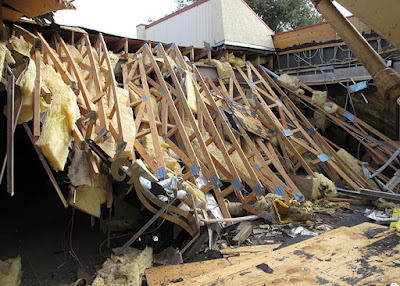In residential construction, a house's structural integrity is paramount. One critical aspect that demands meticulous attention is the installation of roof struts and tie-down connections. Neglecting these elements can lead to significant issues, compromising the safety and stability of the entire roof frame. This article delves into the AS 1684.2—2010 guidelines for residential timber-framed construction related to roof strutting and tie-down connections. We will explore the implications of missing or improperly installed roof struts and the non-compliance of tie-down details, highlighting their designation as major structural defects.
Understanding Roof Strutting
Roof strutting involves providing additional support to roof members, such as under-purlins, ridge boards, and hip and valley rafters. The primary purpose of struts is to enhance the load-carrying capacity of the roof and distribute forces more efficiently. AS 1684.2—2010 states that struts must be supported off walls, strutting beams, combined hanging/strutting beams, or combined counter/strutting beams. Importantly, struts should not be supported on hanging or counter beams.
Proper Alignment of Roof Struts
Excerpt from the Australian Standards 1684.2-2010AS 1684.2—2010 mandates that struts should either be vertical or perpendicular to the rafters or at an angle between vertical and perpendicular to the rafter. In the case of angled struts, they must be birdsmouthed or halved to under-purlins, ensuring a secure and robust connection. Figures 7.9 and 7.10 in the guideline illustrate the recommended configurations for these connections.
Alternative Strut Support Methods
In specific scenarios, struts may not be birds mouthed or halved to the under-purlin but are positioned between vertical and perpendicular to rafters. In such cases, an acceptable alternative involves using a 30 × 0.8 G.I. strap. The strap should be passed over the under-purlin and nailed to each side of the strut with 4/30 × 2.8 dia. nails. Additionally, the strap should be nailed to the under-purlin with 2/30 × 2.8 dia. nails on each side, supplemented by at least 2 skew nails. Alternatively, a framing anchor with four nails to each leg may be employed as a substitute for the strap.
Stud Support and Restraint for Non-Vertical Struts
When dealing with struts that are not vertical, proper stud support or stiffening of top plates is necessary to ensure stability. AS 1684.2—2010 outlines Clause 6.3.2.2 for determining studs supporting struts or Clause 6.2.2.3 for stiffening top plates, depending on the situation. To further enhance the stability of non-vertical struts, blocks or chocks can be used as restraints, as shown in Figure 7.10.
The Consequences of Missing or Improper Roof Strutting and Tie-Down Connections
Failing to adhere to the AS 1684.2—2010 guidelines regarding roof strutting and tie-down connections can have severe implications for the structural integrity of a residential building. In the event of extreme weather conditions, such as storms or hurricanes, the roof may be unable to withstand the forces exerted on it. This vulnerability poses significant risks to the occupants and the property itself.
Designation as Major Structural Defect / Non-Compliance
According to industry standards, the absence or improper installation of roof struts and tie-down connections is classified as a major structural defect and non-compliance. A major structural defect refers to any flaw or deficiency that undermines the structural stability of the building, rendering it unsafe and unsuitable for occupancy. Non-compliance pertains to the failure to adhere to the specific construction regulations and guidelines set forth by AS 1684.2—2010.
The Importance of Professional Assessment and Remedial Work
Inspector WestGiven the seriousness of a major structural defect and non-compliance in roof strutting and tie-down connections, immediate action is essential. Engaging a qualified and experienced professional to assess the roof frame is paramount. The expert will conduct a comprehensive inspection to determine the extent of the issue and recommend necessary remedial measures.
Mitigating Potential Risks
Taking swift and appropriate action is crucial to mitigate the potential risks associated with roof strutting and tie-down connection issues. Following the expert's recommendations and carrying out the required remedial work ensures compliance with AS 1684.2—2010 and reestablishes the structural integrity of the roof frame.
Conclusion
In conclusion, adhering to the guidelines outlined in AS 1684.2—2010 for roof strutting and tie-down connections is not merely a matter of meeting regulatory requirements but a crucial step in safeguarding the structural integrity of a residential building. A minor oversight in these critical areas can lead to major structural defects and non-compliance, jeopardising the safety of occupants and the property. By prioritising proper roof strutting and tie-down connections, homeowners and builders can ensure their homes stand strong and resilient against the forces of nature.
If you are a homeowner and concerned about the structural integrity of your roof frame or suspect any issues with roof strutting and tie-down connections, we highly recommend seeking a professional inspection. Inspector West, a reputable and experienced inspection service, specialises in assessing residential roof frames and identifying potential defects. Their team of qualified experts will conduct a thorough examination, providing you with valuable insights and recommendations for remedial work if necessary.
Don't compromise the safety and stability of your home. Contact Inspector West today in Perth, Australia to schedule a roof frame inspection and ensure industry standards and regulations compliance.
Website: www.inspectorwest.com.au
Phone: 1300 080 554
Email: brian@inspectorwest.com.au
By choosing Inspector West, you proactively protect your investment and ensure a safe living environment for you and your family.









No comments:
Post a Comment